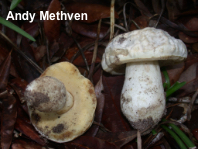| Major Groups > Boletes > Edulis Group > Boletus albisulphureus |

|
Boletus albisulphureus [ Basidiomycota > Boletales > Boletaceae > Boletus . . . ] by Michael Kuo "Very attractive with its soft white cap and yellow tubes," wrote the original author of this species (Murrill, 1945), describing a type collection from a single specimen collected in northern Florida. There aren't a lot of white boletes, and Boletus albisulphureus is fairly easily distinguished among them. It is an oak-associated species from the southeastern United States and the Gulf Coast, which eliminates confusion with Boletus barrowsii, which is a western, conifer-associated species. It might be confused with Tylopilus rhodsiae or Boletus firmus (also known as Boletus piedmonentensis), but examination of the pore surface will quickly sort things out: the pore surface of Boletus albisulphureus is white when young, but it soon becomes yellow—while the pore surface of Boletus firmus is orangish red, and in Tylopilus rhodsiae the pore surface becomes pink. Additionally, Boletus firmus has a cap that is usually a bit more brownish than white, and Tylopilus rhodsiae is associated with conifers. Boletus albisulphureus appears to belong in the Boletus edulis species group, based on its stature, the fine reticulation on its stem, and the way the pores appear "stuffed" and white when the mushrooms are young. Singer (1945) suspected this, but contemporary, DNA-based research has not addressed the issue, to my knowledge. Thanks to Andy Methven for collecting, documenting, and facilitating study of Boletus albisulphureus. Description: Ecology: Mycorrhizal with oaks; growing alone, scattered, or gregariously; summer and fall; ranging from eastern Texas to Florida and North Carolina. The illustrated and described collection is from Georgia. Note: The description below represents a collection of somewhat immature specimens. Cap: 4–5.5 cm; convex; dry; slightly wrinkled; bald; white to whitish. Pore Surface: Whitish and appearing "stuffed" when young; becoming yellow; not bruising; 1–2 pores per mm; tubes to 5 mm deep. Stem: 5 cm long; 1.5–2 cm thick at apex; 2–3 cm thick at base; club-shaped; solid; dry; whitish; finely reticulate over the upper portion; bald and smooth elsewhere. Flesh: Whitish to pale yellow; not staining on exposure. Odor and Taste: Not distinctive. Microscopic Features: Pleurocystidia 30–40 x 5–7.5 µm; lageniform; smooth; thin-walled; hyaline in KOH. Cheilocystidia 20–25 x 5–7.5 µm; fusiform; smooth; thin-walled; hyaline in KOH. Basidioles 20–25 x 4–6 µm; subclavate. Pileipellis a cutis; elements 5–8 µm wide, smooth, hyaline in KOH; exserted hyphal ends cylindric with rounded, subclavate, or somewhat irregular apices. REFERENCES: (W. A. Murrill, 1945) W. A. Murrill, 1945. (Singer, 1945; Phillips, 1991/2005; Metzler & Metzler, 1992; Both, 1993; Bessette et al., 2000; Binion et al., 2008; Bessette et al., 2016.) Herb. Kuo 08192002 (portion of ASM 12448). This site contains no information about the edibility or toxicity of mushrooms. |
© MushroomExpert.Com |
|
Cite this page as: Kuo, M. (2020, August). Boletus albisulphureus. Retrieved from the MushroomExpert.Com Web site: http://www.mushroomexpert.com/boletus_albisulphureus.html |
